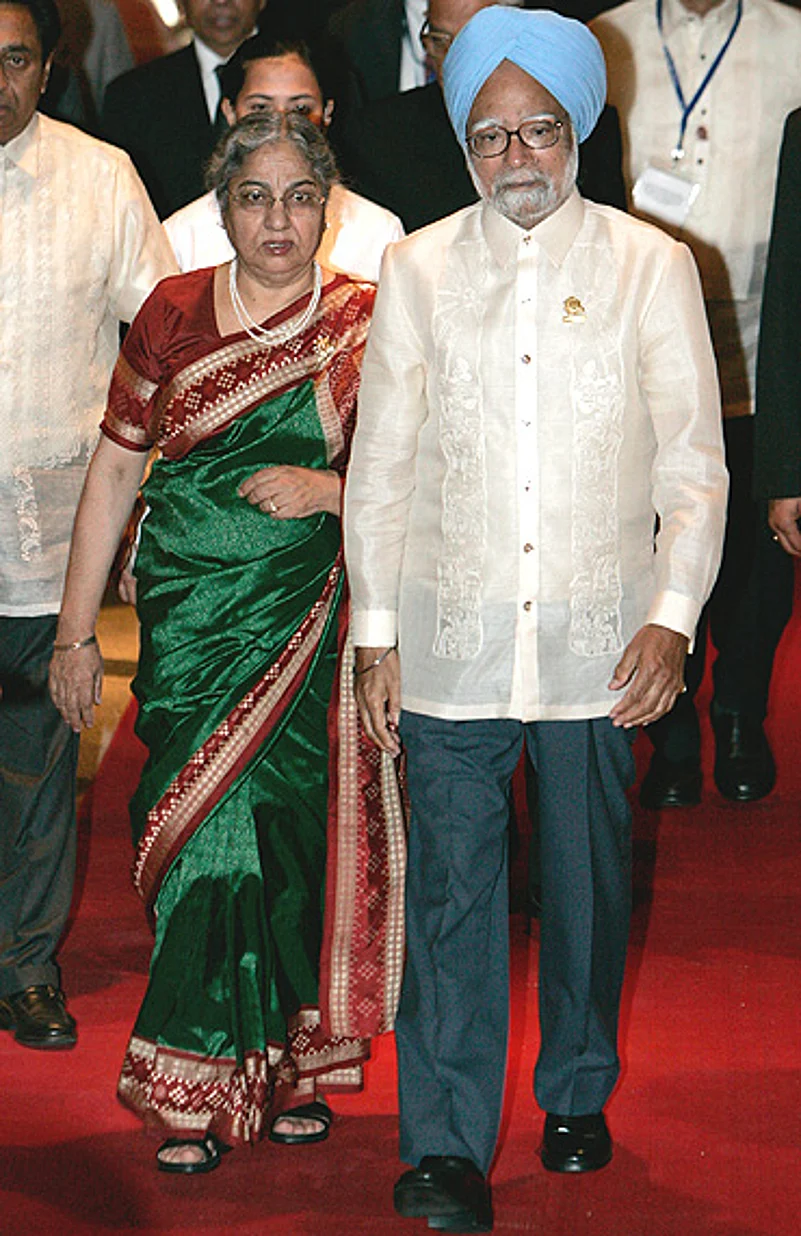
She came. No fanfare of police escort cars with screaming sirens or flashing red lights. She saw my daughter and grand-daughter strolling on the lawn in front of my flat, stopped her car and joined them. Then the four of them, including Reeta, trooped into my sitting room where I awaited her beside a blazing log fire. I began my interrogation.
Gursharan Kaur's family came from Dhakam village in Jhelum district. They were in a small trading business. Her father studied only up to matric and got a clerical-level job in Burmah Shell. They paid their junior staff well. He was able to send his children to school wherever he was posted. Gursharan was the third of his five daughters and son. (They all live around Delhi but no one has heard any of them boasting about their relationship).
Gursharan was born in Jalandhar in 1937. Soon after, her father was transferred to Nowshera near Peshawar. Her early schooling was in a Singh Sabha school for girls. "Were you good at your studies?" I asked her. She smiled, "Average. Not like Manmohan. I managed to pass my exams. I was more interested in games and in singing Gurbani."
She was ten years old when her father was transferred to Amritsar in May 1947. They were lucky to escape the massacres that accompanied the partition of the country. Most of her schooling was in Amritsar and Patiala. She went to the Guru Nanak Kanya Pathshala for her matriculation and the Government College for Women in Patiala for her graduation. She got her BT (Bachelor of Teaching) from Khalsa College, Amritsar. She intended to be a school teacher.
Manmohan's family had migrated from Gah village in Chakwal district, now in Pakistan, to Amritsar. He came with a formidable reputation for scholarship. He had won a stipend to do his tripos from St John's College, Cambridge. He topped with a first class first and took a teaching job with Punjab University, Chandigarh. His parents were looking out for a suitable bride for him. Hers were looking for a suitable match for their third daughter. Both were Kohlis, a sub-sect of Kukrains, comprising Anands, Chaddhas, Sahnis and some others, who prefer to marry within the biradari.
They got engaged without ever having seen each other, but were allowed to meet after the engagement. They got married in 1958. No time was wasted on romance. Their first child was on the way almost immediately after their marriage.
The couple liked life in Chandigarh. They built themselves a small villa with a garden space in Sector 11, within walking distance of the university campus, and planned to settle there. That was not to be. In 1961 Manmohan got a scholarship to do a doctorate from Nuffield College, Oxford. This time, he took his wife and baby daughter with him.
I asked her whether she joined some institution for further studies. "No," she replied, "we always had a stream of relatives and friends descending on us. All my time was taken up making chapatis and cooking dal. Whether it was Oxford, Chandigarh, New York, Bombay, Delhi or elsewhere, for me it was the kitchen."
Though the cliche describes the wife as the better half, a more fitting description for Gursharan would be to say that she played second fiddle—caretaker and cook for her husband and three daughters. Though she did not go to a finishing school, she imbibed some western sophistication when Manmohan was with UNCTAD in New York for three years, professor at the Delhi School of Economics for three years, governor of the Reserve Bank of India in Bombay, and finance minister, before becoming the prime minister of India. But the image of Gursharan as just a housewife would be deceptive: she is also the power behind the throne.
The two make an ideal couple in the Indian tradition: strictly loyal to each other, with an abiding faith in their Gurus and religious traditions. I asked her whether she had ever questioned the existence of God. She looked uneasy and replied: "How can anyone? Our Gurus taught us to believe in God." I changed the subject.
"How did you take to Upinder's decision to marry a Hindu?" I asked. She conceded that they resisted it initially, but gave in because she was quite determined to marry him and he was a nice person.
When Manmohan was back at the Delhi School of Economics, they bought a flat in Ashok Vihar, a congested, middle-class colony. There was a peepal tree across the road which soon had a temple built around it—clanging bells, conch shells blowing, hymns being chanted almost round the clock. "We could not work or sleep. So we gave it to Upinder and her husband and shifted to a professor's quarters at the Delhi School of Economics. We were lucky. In November 1984, a mob of goondas tried to set fire to it, shouting: 'Sikh ka makaan hai, jalaa do.' Vijay Tankha stepped out and confronted the mob, shouting back: 'This is my house. I am a Hindu.' The mob didn't touch it."
"Kum aa gaya Hindu jamaee—so the Hindu son-in-law came in handy," I said. She laughed, "Haan kum aa gaya."
It is their religion that has taught them the virtues of humility and uncompromising honesty. It is hard to believe that after the positions he has held, all they own today is their little home in Chandigarh and a DDA flat in Delhi. (He bought an apartment in Guwahati only to qualify as a voter and be elected to the Rajya Sabha.)
It is harder to believe that with a modest education, Gursharan Kaur is able to discharge the duties expected to be performed by the wife of a prime minister with such accomplishment and grace. She is a person of great dignity, speaks very well in Hindi, Punjabi and English, exudes warmth, and makes everyone feel comfortable.
The interview lasted over an hour. I ran out of questions. She asked me: "Can I leave now?"
"This time I did not ask you to go," I replied.



















